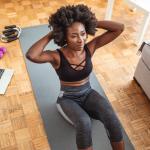
Although it’s tempting to curl up at home when dealing with a heavy flow, staying active could be just what you need to help relieve fibroid symptoms. Exercise can boost your energy, improve your mood, and tap into your body’s natural painkillers.
If you are experiencing a heavy flow, you may be steering clear of exercise out of concern for potential leakage or overflow. To help avoid this embarrassment, follow these helpful tips:
- First of all, wear dark pants –– just in case
- Consider using a pantyliner for a little extra security
- Keep in mind that you can always change your period product soon after your workout
- Make sure you’re using the right period products
For the greatest comfort during physical activity, we recommend choosing the smallest or thinnest product possible –– whether a tampon, pad, or menstrual cup –– that still effectively manages your flow during workouts.
It’s also important to understand that a heavy flow could be a symptom of uterine fibroids. Take our fibroid symptom risk assessment to learn more about your symptoms and if they could be related to fibroids.
Staying Active Can Relieve Some PMS Symptoms
Do you dread getting your period every month? Many women experience painful symptoms associated with their period every month, however, you may be surprised to learn that exercise can actually help alleviate period pain.
Exercise activates our bodies’ internal painkillers, called endorphins. The body releases these natural chemicals during strenuous activity, emotional stress, and physical pain. They can trigger positive emotions and provide natural pain relief, thereby reducing fibroid-related menstrual cramps and other related discomforts. Being active can also reverse fatigue, combat bloating, help you sleep better, and generally improve your mood.
Best Exercises for When You’re On Your Period
When it comes to exercise and fibroids, your best bet is cardio for symptomatic relief. Cardio exercises include walking, jogging, biking, swimming, and aerobics. If you’re not a fan of cardio, or have received medical advice against it, the good news is that any type of physical activity is beneficial for your health. You may want to consider trying weight lifting, martial arts, yoga, or pilates.
Although there aren’t usually restrictions on exercising during menstruation, ask your doctor about your unique situation. One thing to remember is that if you are anemic due to heavy bleeding from fibroids, you should probably stick to lower intensity exercise. Anemia can cause weakness, fatigue, shortness of breath, and dizziness –– so please use caution when active.
While staying active can certainly help alleviate some PMS and fibroid symptoms, you shouldn’t have to endure these issues forever. Relief is possible, and non-surgical treatments like Uterine Fibroid Embolization (UFE) can offer lasting solutions for fibroid-related pain and heavy bleeding, allowing you to regain control over your health and quality of life.
Menstrual Cups for Active Women with a Heavy Flow
More and more women are turning to menstrual cups as an environmentally-friendly alternative to pads or tampons. Menstrual cups come in different shapes and sizes to fit your personal needs.
Many menstrual cups can hold around 20 milliliters of fluid. This size can last 6-12 hours for women with an average flow, though it may not be sufficient for a heavy flow. Some menstrual cups on the market can hold over 40 milliliters.
If you’re interested in using a menstrual cup during exercise, finding the right one is key. While larger cups can better manage a heavy flow, these may not be the right choice for everyone. On the other hand, smaller cups may be more comfortable, but have a higher potential for leakage. You may need to experiment a bit before settling on the right cup.
If your flow is heavy but you prefer a smaller size for active days, you can always empty it after exercise and throughout the day. Keeping an extra one available can help with when you’re out and about.
Heavy Flow Tampons for Active Women
Tampons are a great option for active women. They are discreet and can be worn with fitted workout pants or even with a swimsuit. Many women find them more comfortable to wear than pads during physical activity since they can’t feel them when properly inserted.
Many major brands have specially designed tampons for active women. Most of the active styles are relatively small, so they may not be absorbent enough for the heavy flow associated with fibroids. You can also find heavy flow active tampons on the market. Some brands sell multi-packs of active tampons in light, regular, and heavy –– this is a good way to experiment and see which sizes and styles work best for you.
If smaller tampons are more comfortable for you when exercising, but you have a heavy flow, you can always change your product soon after you finish.
Heavy Flow Pads for Active Women
Some women prefer wearing pads. Others, experiencing a heavy flow, may need to double up with both tampons and pads to avoid overflow and stained clothing. In either case, active women may want to try an ultra-thin style pad with wings –– some of which are designed specifically for heavy flow.
Because everyone’s shape is different, the reality is that some pads will work better than others. Again, you may need to experiment with different styles to find the right one for you.
How Often Should You Be Changing Your Feminine Hygiene Products?
If you’ve noticed your flow seems heavier during physical activity, that’s because it probably is –– exercise can cause menstrual blood to release from the uterus faster. Interestingly, women that exercise regularly may notice an overall decrease in their monthly flow. Regardless, you should always change your feminine hygiene products at appropriate intervals.

Menstrual Cups: Menstrual cups are perhaps the longest-lasting option and can be left in place for up to 12 hours. However, depending on the size of your cup and the heaviness of your flow, you may need to empty the cup more often to avoid inconvenient accidents and stained clothing.

Tampons: The US Food and Drug Administration (FDA) recommends changing your tampon every 4-8 hours to avoid the risk of toxic shock syndrome (TSS). Always wear the smallest size possible that effectively manages your flow, and never leave a tampon inserted for longer than 8 hours.

Pads: Recommendations for how often to change feminine pads are dependent on the type of flow. Generally speaking you should change yours as often as needed to avoid overflow. Some women with fibroids may soak through a maxi-pad within an hour. Those with a more moderate flow may only need to change pads every 6-8 hours.
When Should a Heavy Period Be Addressed?
When it comes to choosing the best period products for staying active, the bottom line is it’s an extremely personal decision. Whether you look for the best menstrual cup for active people with heavy flow, heavy flow active tampons, or pads for heavy flow, active lifestyle choices are beneficial for fibroid symptom relief and your overall health.
We applaud your efforts to stay active during your heavy period days! Along with regular exercise, our experts at USA Fibroid Centers recommend tracking any changes in your period –– such as its length, flow rate, and associated clots. Always discuss any changes with your doctor, since the development of heavy, lengthy periods can indicate that something is wrong.
Our fibroid specialists are top-rated experts in determining if your period changes are caused by uterine fibroids, ADENOMYOSIS, or some other condition entirely. If you are experiencing heavy periods or other uncomfortable symptoms, we are here to help. Schedule an appointment today for an initial consultation.



